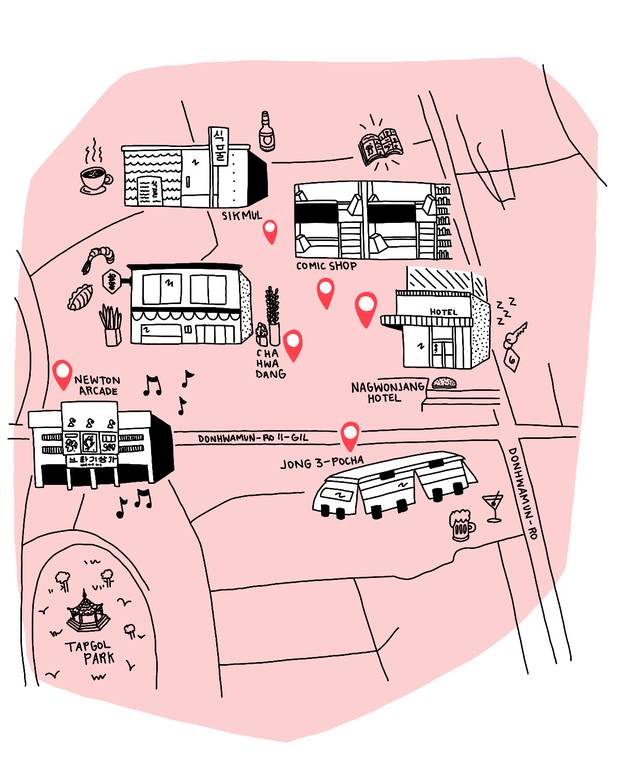Five years ago, before Ikseon-dong was touched by gentrification, the neighbourhood, often described as a hidden treasure and a secret place, was pitch black on a moonless night. This city-centre locality was once mostly populated by grandmas who, by day, did laundry and chatted on the stoop.
One of the oldest neighbourhoods in Seoul, Ikseon-dong is made up of a dozen or so alleyways lined with hanoks, or traditional Korean homes that date back to the 1920s – one-storey structures with tiled roofs and wooden pillars. The sight of them tightly knitted together provides a stark contrast to the skyscrapers of the modern-day capital. While a handful of hanok neighbourhoods still exist in Seoul, none have seen change as quickly and drastically as Ikseon-dong. The area was known as a red-light district in the 1950s and 60s and nearly demolished under a government plan proposed in 2004, but a group of artists and entrepreneurs have been redeveloping it since 2013.
The usual arguments about gentrification persist – those against it argue the new cafés and shops ruin the authenticity of the hanok-island and question whether the older generation previously living here was sufficiently compensated for their homes, while defenders point out the eagerness of many residents to leave, as well as the good that the businesses have done for hanok awareness.
No matter which side of the argument you're on, it's difficult not to be charmed by a warm cup of coffee in a place reminiscent of Korea's past. And even on Ikseon-dong's busiest night, no one can deny the still-secret feeling of the narrow alleyways.
Stay
Nagwonjang Hotel
The details in Hotel Nagwonjang recollect the past and celebrate the neighbourhood.
Catering to young couples looking for stylish yet budget accommodations, Hotel Nagwonjang opened its doors April of last year. It's a six-storey red-brick structure with an elegant blue lobby on the first floor and a backstory that's something like a Cinderella tale.
Originally constructed in the 1980s, it first existed as a yeogwan, a type of lower-tier lodging. During its second life, the space became a slightly more recognized venue by the name of Greenfield Motel.
Iksundada played fairy godparents to the space, taking cues from the Ace hotel chain. Collaborating with different artists, Iksundada transformed the structure into one of Seoul's most talked-about hotels.
Rooms range from $56 to $90 (U.S.).
Nagwonjang boasts 18 guest rooms, private dining facilities, a patio garden and a rooftop overlooking the neighbourhood's hanoks. The real charm of the hotel is looking at the details and seeing how well they recollect the past and celebrate the neighbourhood.
The hotel's faded, metal keychains with "Nagwonjang" written in Korean adds a nice, analog touch to the experience. Every detail of the guestroom – the curtains on the windows, the hanging plants – is the creation of a local artist and available for purchase.
Rooms range from $56 to $90 (U.S.) and are especially in demand during holidays. Every visit comes with a free welcome from Bok Soon, Nagwonjang's friendly golden retriever. 25, Supyo-ro 28-gil, Jongno-gu, Seoul. nagwonjang.com
Eat and drink
Chang Hwa Dang
One of the most popular eateries in the neighbourhood, Chang Hwa Dang specializes in mandu (Korean-style dumplings). Although lines for the restaurant can be painfully long, customers can pass the time by peering into the kitchen through large windows as the cooks carefully craft each piece. Mandus come in four different flavours – steamed meat, kimchi, shrimp and charcoaled meat – and are often paired with an item from the Meals for One side of the menu. The traditional tteok-bokki (spicy rice cakes), a delicious combination of crunch and spice, complement the dumplings well. 23 Supyo-ro 28-gil, Jongno-gu, Seoul. instagram.com/chang.hwa.dang
Sikmul
Sip creamy coffee cocktails around retro Korean-style furniture at Sikmul.
Many Ikseon-dong lovers would argue that none of the newer cafés and bars holds a candle to Sikmul – the first venue to put Ikseon-dong on the map. After falling in love with the then-quiet neighbourhood, photographer and former art director Louis Park salvaged one of the hanoks and developed it into this space in 2014. Wanting to keep remnants of the building's original nature, he constructed a few of the walls with the broken tiles of the original rooftop and brought in retro Korean-style furniture. Park's favourite sounds include Wong Kar-wai soundtracks and Chet Baker LPs, and can be heard throughout the space. For the best of both worlds, try their creamy, rich coffee-cocktails named Boy and Girl. 46-1 Donhwamun-ro 11da-gil, Jongno-gu, Seoul. instagram.com/sikmul
Comics Shop
A modern-style manhwa-bang (venue for reading comic books), this "shop" allows you to rent a small booth for reading comics, drinking coffee and having snacks. Booths start at roughly $2 a person and add on fifty cents (U.S.) for every 10 minutes. Comics are arranged by genres into a mini-library and the selection includes everything from popular titles to art books and old copies of Mad magazine. Few books are in English, but you'll find plenty of hanging out rather than serious reading. The snack bar includes a wide selection of Korean instant noodles – making it the perfect indoor activity for rainy days. 33-7 Supyo-ro 28-gil, Jongno-gu, Seoul.
Local secrets
Nagwon Arcade
A few hundred musical-instrument shops are gathered in this plaza. You'll find grandpas tuning pianos and school-aged children trying out their first violin. 428, Samil-daero, Jongno-gu, Seoul.
Jong 3-pocha
One of the most recognized LGBT-friendly spots in Seoul, Jongno has long been understood as a respite for older gay men. With all the changes in the neighbourhood however, the scene is growing increasingly younger and diverse. 21 Donhwamun-ro 11-gil, Jongno-gu, Seoul.

